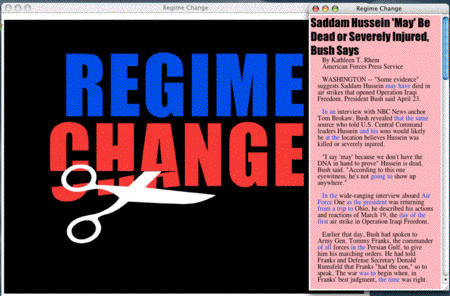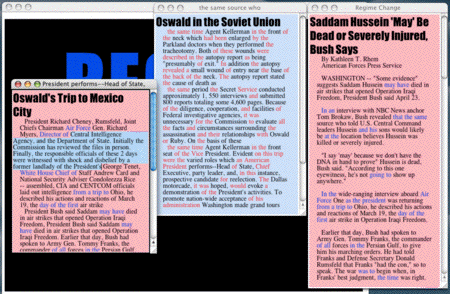Documentation

Regime Change is a text you play. The result of your play will be an altered version of a starting document — but, as with any play, the real interest is in the playing.

Regime Change begins by displaying a news story. Then words in that story, pair by pair, become highlighted. Clicking on words opens a new window (though this only becomes possible once all the highlighting is completed, and windows should not be closed while highlights are in the process of appearing). Interacting with new windows produces new texts that will take the place of the clicked words.

New windows contain texts that begin with the words clicked in the previous window. Each paragraph in the new window is an alternative text — beginning with the same words but potentially (though not necessarily) following many different paths from there. These texts are generated by connecting chains of words that may have appeared originally in very different parts of the source document.

A new window's texts, once displayed, also begin to have words highlighted within them. Clicking highlighted words will open another new window, containing generated texts that can take the place of the clicked words. Opening several generations of windows opens wider possibility spaces for the texts that will be created (and that will replace the clicked words in earlier-generation windows).

In any window with generated text, clicking a non-highlighted word will close the window — and select a text. The selected text will run from the beginning of the clicked paragraph to the clicked word. That selected text will then take the place of the words clicked to open the window. This creates a kind of stretchtext — the pair of words clicked to open a window are replaced with the words selected in the open window (usually more than a pair).

After opening several layers of windows, part of play is keeping track of where each window came from — so that it can be collapsed by selecting a word that will make a pleasing segue at the point where it will join the text to which the player intends to connect it. (This may be more than one layer down.) Creating an interesting segue is made easier by flexibility in whether you include punctuation when clicking a non-highlighted word. Clicking the main body of the word leaves punctuation out of the selection (including "apostrophe s" and other contractions). Clicking the punctuation itself (or the end of the contraction) includes it in the selection.




Regime Change is our first textual instrument — our first experiment with this new way of playing with language and thinking about how we use it.